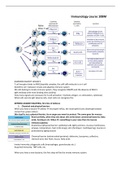Immunology course 10BM
ASNWERS KAHOOT LESSON 1:
T cell receptor binds to MHC/peptide complex, the cd4-cd8 molecule is on t-cell
Dendritic cell : between innate and adaptive immune system
NK cells belong to innate immune system, they recognize DAMPS and the absence of MHC1
IgM antibody with most binding sites (avidity)
How many signals are necessary for b-cell activation: 3 (whole antigen, co-stimulation, cytokines)
What cells secrete IgE? plasma cells, mast cells can recognize this
DEFENSE AGAINST BACTERIA, first line of defence
1. Chemical and physical barriers
When you have a wound → yellow → neutrophil reflux, the neutrophils burst (myeloperoxidase
comes free: green colour)
Skin itself is not a physical barrier, its an organ you want to protect. The same goes for mucosa
Read carefully, when they ask about skin write down commensal bacteria, fatty
acids, hornlayer etc. When it’s something in your nose than its mucosa
immune response:
Anatomical (physical) barrier: epithelial cells tight junctions, mucous membranes,
airways, temperature, hairs (cilia lungs), skin (hornlayer: multilayering), mucosa is
protected by tightjunctions
Chemical barrier (antimicrobial proteins): defensins, lysozymes, collectins,
stomach acid, tear fluid, mucus, fatty acids
Innate immunity: phagocytic cells (macrophages, granulocytes etc.)
Acquired Immunity: TMP cells, etc.
When you have a new bacteria, the first days will be the innate immune system.
,Deep in the skin:
Immunity comes from multilayered epithelium, stratum corneum, target, commensals
Deeper into the mucous membranes:
cilia (cilia), mucus (mucosa layer), acidity (think of intestinal infections, then the bacteria must first
pass through the stomach with a low pH), commensals (e.g. in the intestines of the respiratory tract)
The epithelium is held together by tight junctions. The internal epithelium is also called mucosal
epithelium "mucosal epithelia". It contains
proteins that produce this mucus. Cilia are also
present on this epithelium. These cilia can expel
pathogens along with the mucus.
The epithelium consists of several layers. These
layers consist of the protein keratin. The
bottom layer is called the basement membrane.
The epithelium contains lamellar bodies. These
are located in the intracellular part of the cell.
They form a waterproof layer and provide an
antimicrobial effect.
Internal epithelium contains a layer called
mucosal epithelia with a flowing fluid called mucus (and mucins proteins). Micro-organisms can stick
in this and be brought out with the help of cilia. Bacteria that are good for you and that may also be
present are called commensal bacteria. They can make and secrete antibacterial substances, but they
can also stimulate epithelial cells to produce antibacterial proteins to separate.
The presence of pathogens is often recognized by an inflammatory response. This causes an
attraction of the immune cells.
Lysozyme: a glycosidase that can break specific bonds in the
peptidoglycan layer. The crosslinks between the GlyNAc and
MurNAc are broken. However, there is a difference between
gram-positive bacteria and gram-negative bacteria. Gram
negative bacteria have an outer membrane and while gram
positive bacteria do not.
Epithelial cells can secrete antimicrobial whitening.
Defensins / cathelicidins is one such substance. These are
positively charged. The membrane is negatively charged.
This difference in charge causes the attraction to create a
pore in the membrane. If you make a hole in the bacteria it will be destroyed
You have different defensins you have the alpha-defensin which is produced by
neutrophils. These are located in the granules of the neutrophil.
Complement system: The complement system takes part in defensive against
bacteria, as well as innate immune system
Complement system : different proteins in the blood. Part of this process is
opsonization. This means that the surface area of a pathogen is modified so that
it can be taken up by phagocytes.
,The different proteins can react with each other and activate different pathways. The ultimate goal is
to kill the pathogen. There are 4 different pathways: Alternative pathway , Classical pathway , Lectin
pathway , Terminal pathway
1. Alternative pathway:
Spontaneous splicing of C3. C4b and C2a can convert C3 to C3b and
C3a. Factor B can bind to C3B. C3b with factor B can be converted
into C3bBb with the help of factor D. This is a C3 convertase =
feedback loop.
2. Classical pathway:
Antibody binds to the
membrane, either IgM of IgG. This is not the case with new
bacteria or viruses They can be recognized by antigens on
the membrane of the pathogen. C1 complex can bind by
C1q. C1r and C1s have an enzyme-like function. They
convert C4 into C4a and C4b and C2 into C2a and C2b. C4b
and C2a together are the C3 convertase. This is again
discussed in the alternative pathway.
3. Lectine route:
Manose is on the membrane of the pathogen (like
bacteria). MBL recognizes this (manose binding lectin).
MASP can also bind to this and then convert C4 into C4a
and C4b and C2 and C2a and C2b. → alternative pathway
4. Terminal route:
C3b binds to C4C2a or C3bBb. This converts C5 into C5a
and C5b. C6 and C7 can bind to C5b. C7 can bind to the
membrane. Then C8 can bind and C9. By binding more C9,
a hole is created in the membrane.
Lectin and alternative are with new bacteria, the classical pathway is there are already antibodies
So the classical pathways does NOT occur from day 1 after infection with new bacteria
!C3 is the most important!
These paths ultimately lead to:
Inflammation: chemotaxis, attracting the immune cells by C5a and C3a (also C4a)
Opsonization: phagocytosis; placing flags → provide signal. By breakdown product of C3
Membrane attack: Lysis, pores form in the membrane of the pathogen (C5-C9)
, Know this picture, not all the pathways^^
NK cells = are formed in the bone marrow from the CLP cell ''common lymphoide progenitor''. They
are important against the immune system of viruses and tumor cells.
NK cells receive positive and negative signals from cells. These ensure that they do or do not kill





